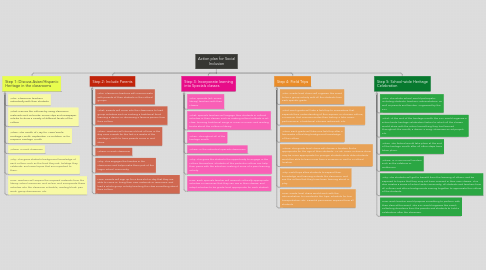Action plan for Social Inclusion
by Kelly Loria

1. Step 1: Discuss Asian/Hispanic Heritage in the classrooms
1.1. Who: Classroom teachers individually with their students
1.2. What: Discuss the cultures by using classroom materials such as books, movie clips and newspaper articles to show a variety of different facets of the culture
1.3. When: The month of May for Asian/Pacific Heritage Month, September 15-October 15 for Hispanic Heritage Month
1.4. Where: In each classroom
1.5. Why: This gives students background knowledge of each culture, such as the food they eat, holidays they celebrate, and news topics that are important to them.
1.6. How: Teachers will acquire the required materials from the library, school resources, and online, and incorporate these activities into the classroom schedule; reading block, pair work, group discussions, etc.
2. Step 3: Incorporate learning into Specials classes
2.1. Who: Specials (art, music, library) teachers with their classes
2.2. What: Specials teachers will engage their students in cultural activities in their classes, such as making cultural artifacts in art class, learning traditional songs or music in music, and reading books about the culture in library.
2.3. When: Throughout all of the heritage month
2.4. Where: In the individual Specials classrooms
2.5. Why: This gives the students the opportunity to engage in the culture themselves. Students of the particular culture can help their peers with the activities, making it more of a peer learning activity.
2.6. How: Each Specials teacher will research culturally appropriate activities or resources that they can use in their classes, and adapt activities to be grade-level appropriate for each student.
3. Step 5: School-wide Heritage Celebration
3.1. Who: The whole school would participate, including students, teachers, administration, as well as parents and families. Organized by the PTA
3.2. What: At the end of the heritage month, the PTA would organize a school-wide heritage celebration festival in which all the classes would share with the school something they had learned throughout the month; a dance, a song, showcase an art project, etc.
3.3. When: The festival would take place at the end of the heritage month after all other steps have taken place.
3.4. Where: In a communal location such as the cafeteria or auditorium
3.5. Why: The students will get to benefit from the learning of others, and be exposed to topics that they may not have covered in their own classes. This also creates a sense of school wide community; all students and teachers from all cultures and ethnic backgrounds coming together to appreciate the culture of the students.
3.6. How: Each teacher would prepare something to perform with their class at the event. The PTA would organize this event, collecting donations from the parents and students to hold a celebration after the showcase.
4. Step 2: Include Parents
4.1. Who: Classroom teachers will communicate with parents of their students in the cultural groups
4.2. What: Parents will come into the classrooms to lead group activities such as cooking a traditional food, learning a dance, or discussing a famous person from their culture
4.3. When: Teachers will choose a block of time in the day once a week for the first 2-3 weeks of the Heritage Month to have parents come in and share
4.4. Where: In each classroom
4.5. Why: This engages the families in the classrooms and helps make them part of the larger school community
4.6. How: Parents will sign up for a time slot or day that they are able to come in, bring their own materials or resources, and lead a whole group activity teaching the class something about their culture
5. Step 4: Field Trips
5.1. Who: Grade level chairs will organize this event to be a group activity with all the students from each specific grade
5.2. What: Each grade will take a field trip to somewhere that expands their understanding of the Hispanic or Chinese culture; a museum that commemorates their history, a latin music performance, a traditional Chinese restaurant, etc.
5.3. When: Each grade will take one field trip after a few weeks of building background knowledge of the culture
5.4. Where: The grade level chairs will choose a location that is appropriate for the age of their students. An art, music or dance show may be more appropriate for younger students while older students would be able to learn more from a museum or visit to a cultural location
5.5. Why: Field trips allow students to expand their knowledge and learning outside the classroom, and see the culture that they have been learning about in play
5.6. How: Grade level chairs would work with the administration to coordinate the trips, schedule for bus transportation, etc. Parental permission required from all students


